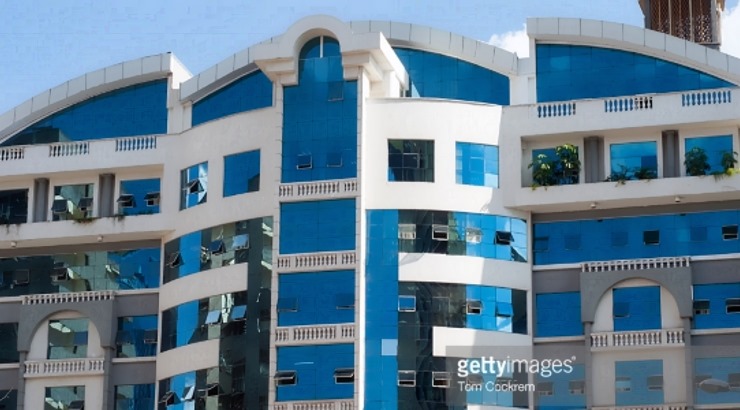Commercial Projects
Nairobi Landlords Struggle with Empty Office Spaces
Nairobi’s skyline is more crowded due to increased office space supply.

A walk into many of the glittering office buildings that have recently sprouted up across Nairobi reveals something rather disturbing.
Empty floors and deserted basement parking lots are unexpected in a booming commercial property market where previously designated residential zones have been converted to mixed-use districts, featuring stylish office parks and apartments.
Nairobi’s busy skyline has over the past five years become more crowded as the supply of office space surges even as developers scramble to attract a declining number of tenants.
In Nairobi’s Upper Hill district, near Hospital Hill Road, the UAP-Old Mutual Tower, Kenya’s tallest building, remains 65 per cent empty ten months after opening.
The 33-storey building, which stands 163m tall with an altitude of 5,700 feet above sea level, unseated Rahimutulla Tower as the highest point in Nairobi in 2015.
UAP-Old Mutual Tower has injected 309,000 square feet of rentable space into the Nairobi commercial property market.
But the tower’s prestige has not been enough to fill its offices. UAP-Old Mutual Group chief executive Peter Mwangi in April that the building’s occupancy stands at 35 per cent and that the company is hoping to realise full occupancy by the end of next year.
This is a too high target to achieve considering that a stone’s throw away is Britam Tower, the tallest building in Kenya, and KCB Plaza, both of which are targeting a similar clientele.
The KCB Plaza comprises 228,330 square feet of rentable space, while Britam Tower is injecting some 339,000 square feet of Grade A office space into the city.
It is the same story in Westlands, where several office parks have recently opened mainly along the busy Waiyaki Way.
According to Cytonn Investments, Nairobi’s office space oversupply is currently 3.2 million square feet and is projected to increase by 21 per cent to 3.9 million square feet next year.
RELATED: Nairobi Skyline to Change Forever as Skyscrapers Soar
This follows increased supply with completions growing at a five-year annual growth rate of 52.6 per cent, from 2.1 million square feet in 2012 to 7.4 million in 2016.
The study observed that the surplus of office space is leading some owners to resort to unconventional measures, like reducing property prices, to attract buyers or tenants.
“Increased supply is constraining performance with occupancy rates and yields declining as rents and prices experience slower growth rates,” Cytonn said.
The firm expects the market glut to continue in the coming months.
“We expect market performance stagnation constrained by the oversupply, slow-down in growth of financial services and SME sectors as well as the upcoming election, which will slow down demand,” Cytonn real estate services manager Johnson Denge.
Cytonn’s findings are similar to those of Knight Frank, which says in its report highlighting property trends in Africa that an oversupply of office blocks has seen the average monthly cost of prime leasing space falling 20 per cent to Sh1,648 per square metre since 2014.
“The high levels of new supply of office space have negatively affected rental levels and occupancy rates,” Knight Frank said.
“Prime rentals declined (over the past two years), which is partly attributable to the exodus of a large number of expatriates following the downsizing of Kenya’s oil extraction industry.”
The high vacancy rates and dwindling rental yields are spelling trouble for high-net worth investors such as pension funds and insurance companies that have committed billions of shillings into development of office parks in the Kenyan capital city.
The market stagnation is expected to weigh heavily on the minds of investors in the near future considering the tough operating environment for businesses with lower turnover and business restructuring, which has led to several companies scaling back operations.
RELATED: Wealthy Builders Shrug Off Nairobi Office Glut Fears
However, Cytonn believes that there is money to be made in the commercial property sector by investors who will tap into specific pockets of value such as office zones with low supply like Gigiri and workplaces with low supply and high returns such as grade A offices.
Property consultant Mentor Management Limited (MML) had last year warned of a looming office glut in Upper Hill and Westlands. In its 2015 office report, MML said that new offices that were underway in Nairobi were likely to take about four years to attain full occupancy.
“With more than another three million square feet coming on stream this year, tenants have more choice and will shop around for convenience and quality at the best price, which, for many, is likely to point them towards the city’s outer office nodes,” James Hoddell, CEO of MML, said in a statement last year.
Mr Hoddell, however, said that “the few buildings opening in Upper Hill and Westlands that have been built to deliver viable parking ratios, and quality finishes” will still fill up.
“The boom in completions this year [2016] is coming three years on from the record office space planning applications in 2013, delivering some 3.8 million square feet of new office space, compared with the previous 2011 record of 2.3 million square feet,” he said.
Slightly more than two million square feet of new office space was injected into the Nairobi market last year, most of which comprised Grade B offices.
This is nearly double the demand for office space, which has remained almost constant since 2013 – rising from 1.3 million square feet in 2014, to 1.33 million square feet in 2015.














